On Monday 9th August, Insolvency Guru Malcolm Niekirk held one of his free Coffee Break Briefing Webinars. In the presentation, Malcolm discussed the relationship between your proposals, the basis for your remuneration, and the role of the committee.
This is the summary article following the briefing. If you'd like to watch back the webinar, you can do so below. If not, read on for a summary.
To keep up to date with Insolvency Law and to be informed of upcoming Coffee Break Briefings, please sign up to our insolvency newsletter here.
Quick Links
This article is lengthy, so we've provided some quick links below to help you find what you need quickly.
- The basic principles for setting the basis for administrators’ remuneration and the value of the remuneration
- The time table, post appointment
- The committee
- Creditor classes – secured & unsecured
- Different administration tracks
- The procedure for approving the basis of remuneration
The basic principles
It is for creditors to approve the basis for your fees. There are three bases:
- Time Costs
- Ad valorem
- Fixed Fees
You can ask for any one of these, or a combination.
The principles behind the law are:
- The creditors who are most affected by it are those who make the decision about the basis of your fees.
- Creditors may delegate that to a committee.
- Creditors also have the job of approving the strategy for the administration (as set out in your proposals).
- If you’re going for the ‘time costs’ basis for your remuneration, then your fees will be capped by your own estimate.
What is the relationship between proposals, remunerations and the committee?

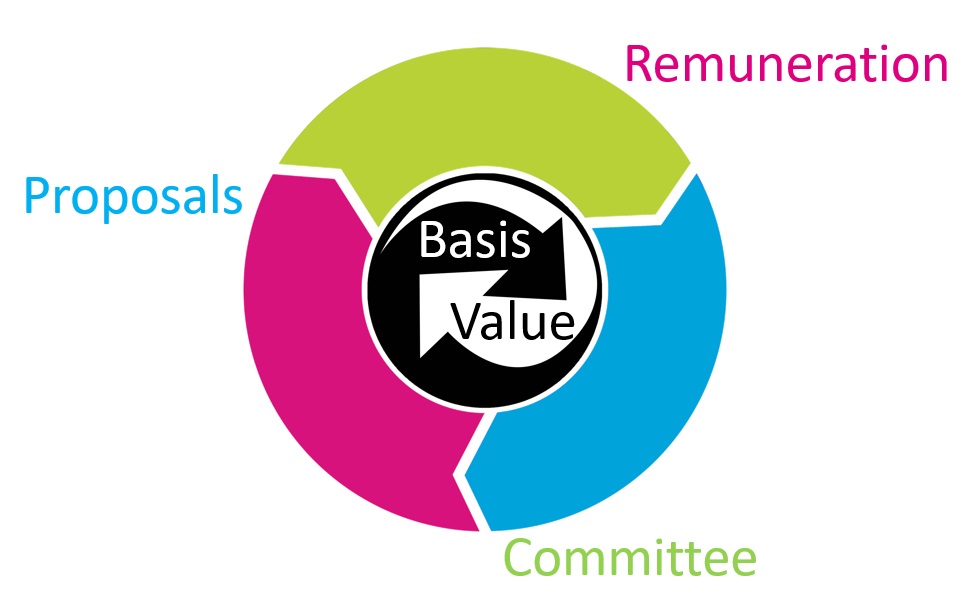
Timetables and post-appointment
There are three key decisions that you have to put to the creditors following your appointment. These are on:
- Proposals. These need:
- Active approval (by deemed consent, or a decision procedure); or
- Deemed approval (if it’s a paragraph 52paragraph 52(1) administration)
- Committee. The creditors are asked:
- Decision to form a committee
- And if so, who is to sit on it
- Remuneration, to confirm:
- Basis
- Fee estimate (if time costs)
The ‘proposals’ and ‘committee’ decisions can be by deemed consent; however, the ‘remuneration basis’ can only be decided by a decision procedure.
Proposals
The rules for the proposals are that:
- You have 8 weeks following the appointment to publish the proposals
- You have 10 weeks to seek approval of the proposals, which may be by deemed consent or a qualifying decision procedure (except from those cases where approval isn’t required, and the proposals can be deemed approved)
When does deemed approval apply?
The cases for which approval isn’t required and will be deemed, are those cases that are running on a paragraph 52(1) track. These are:
- paragraph 52(1)(a) - an administration where all creditors will be paid in full.
- paragraph 52(1)(b) - the unsecured creditors are getting nothing at all from the administration (except perhaps through the prescribed part)
- paragraph 52(1)(c) - the only possible statutory purpose is asset realisation for either:
- one or more secured creditors, or
- preferential creditors
When deemed approval does not apply in a paragraph 52(1) administration?
If you’ve got a case which is on a paragraph 52(1) track, you have the right to treat the proposals as deemed to be approved.
But you also have the right to ask creditors expressly to approve them, either through deemed consent or a decision procedure.
Also, suppose creditors feel that they are being excluded and want to do something about that. They have a limited statutory right to trigger a decision procedure; to make you to ask them for express approval of your proposals.
Which proposals require active and deemed approval?
This shows which proposals require a decision procedures or deemed consent, and which can be deemed to be approved.
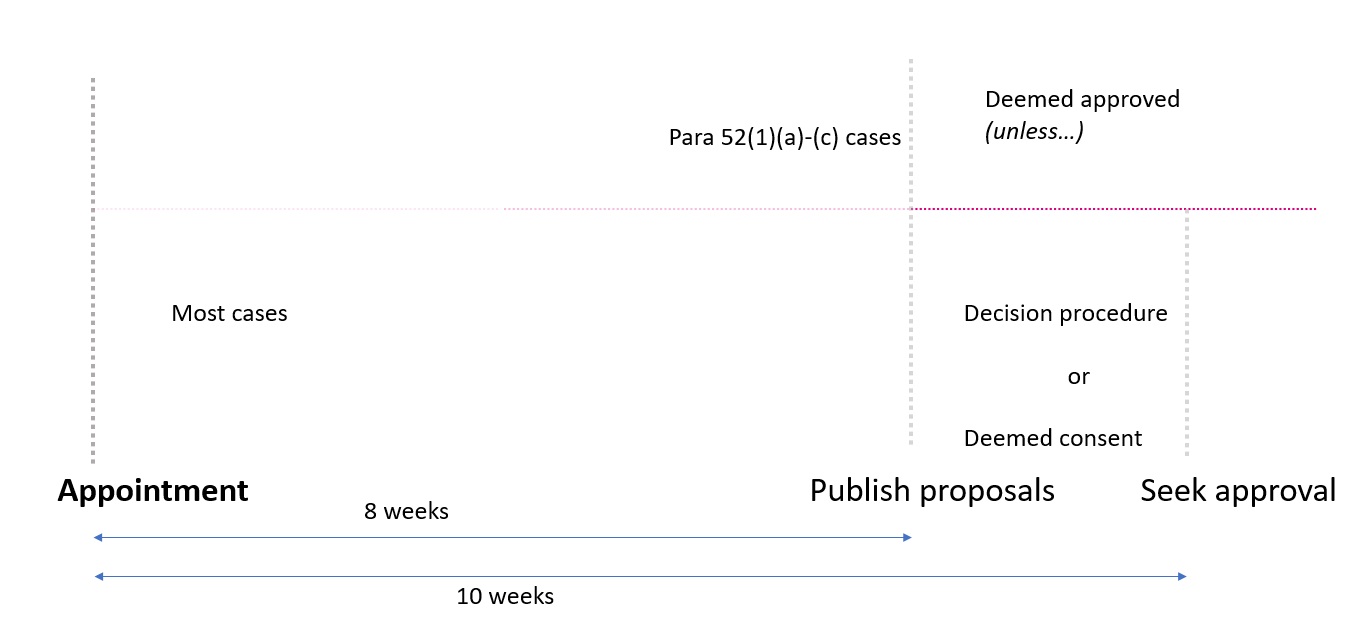
The demarcation line in the diagram darkens from the date which you publish the proposals. This is because it’s the opinion that you state in your proposals that defines whether the administration runs on a paragraph 52(1) track or not.
Once the administration has been put on the paragraph 52(1) track, it stays on that track.
Committee
You have to ask the creditors if they want to set up a committee. The triggers for that are:
- When you ask them to approve proposals (even if by deemed consent)
- Whenever you ask them to decide anything else (even if by deemed consent) if there’s not already a committee
The decision to set up a committee is conditional on three or more creditors being willing to sit on it.
When don’t you need to ask for a committee?
You don’t need to ask for a committee if:
- The administration is put on a paragraph 52(1) track; and
- You’re getting your proposals ‘deemed approved’
Committee establishment – easy compliant procedure:
- Circulate a deemed consent notice
- Follow the wording in the legislation
The Rules suggest that you must use deemed consent (if it’s permitted) or a decision procedure whenever you ask creditors to decide something. I think that means you should follow one of those procedures to invite creditors to set up a committee.
I suggest you follow the statutory wording, and use a deemed consent notice. That means that there is likely to be a decision to form a committee. But, it will be ineffective, unless there is real enthusiasm from the creditors (shown by three or more putting themselves forward to sit on it).
Remuneration
Remuneration has to be fixed as one of these bases:
- Percentage of
- Total value; or
- Realisations/distributions/both
- Time costs
- Set fee
- Or a combination of two or more (ad valorem, time costs, set fee)
Creditors are entitled to detailed information to make an informed decision.
What factors should you use to recommend the basis for your remuneration?
The basis for insolvency practitioners’ remuneration must reflect these statutory points:
- Complexity
- Responsibility
- Effectiveness
- Value (and type of property)
You can expect your arguments, based on those points, to be examined closely if you have to get the basis for your remuneration set by a court. So it is important that your request to the creditors should explain why you are seeking a particular basis, by reference to those points.
Remuneration – the basis
These are the principles:
In all cases you start with the committee (to set the basis for your remuneration), if there is one. If there isn’t a committee, or they don’t set your remuneration, the decision moves to the creditors.
In some paragraph 52(1) cases, there rules about which creditors make the decision.
If all else fails, you will have to go to court. The final time limit for going to court is 18 months. That effectively means that you have to do your level best to get creditor approval for the basis for your fees well within the first 18 months after you are appointed.
Is a committee required?
Because you can control the timing of the decision about appointing a committee, you have a lot of influence about whether there is a committee to approve your remunerations.
Although you have to start with the committee, you have quite a lot of discretion and leeway.
Once set up, the committee cannot act until it is ‘established’. So a creditors’ resolution passed before then will be effective.
What are the different classes of creditors?

Key points to remember are:
- Secured, creditors include those with rights of ownership of assets. So, they include factors and invoice discounters, hire purchase, and leasing companies, and even trade suppliers with effective retention of title claims.
- Unsecured creditors include not only ordinary unsecured creditors but preferential creditors as well.
What are the different flavours of administrations?
Different rules apply for approving the basis for your remuneration. They depend on which creditors you think will be ‘in the money’.
The principle is this; the creditors who decide how you are to be paid are those affected by the decision.
The rules are based on those for approving your proposals.
The flavours of administrations
This shows a full range of administrations, where quality is assumed to have a linear relationship to the result that you get (measured by the result for creditors).
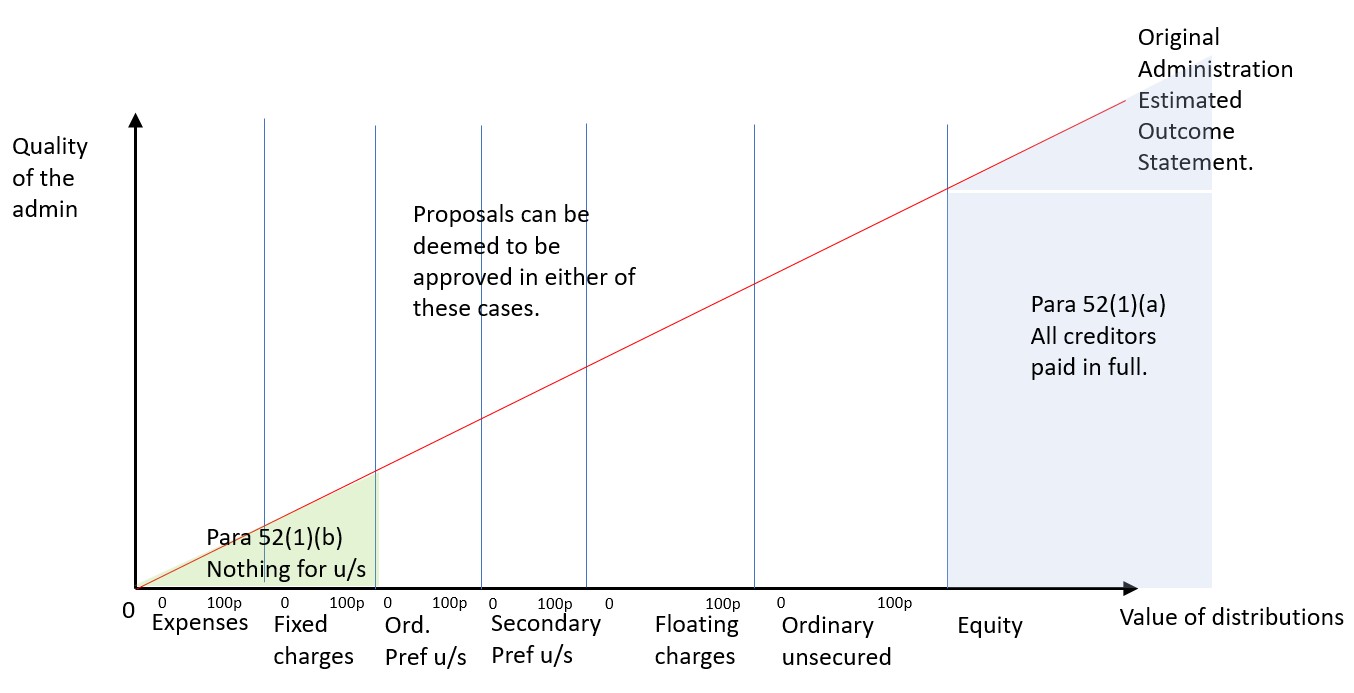
In the bottom left hand corner, you have the type of administrations that you don’t want; where you’re not even getting enough realisations to pay your own expenses – let alone distributions to creditors.
At the other end of the scale in the top right, are the very best administrations which pay all the creditors all that they are owed, and also return capital to the shareholders.
The cases in the right-hand side are the paragraph 52(1)(a) cases, those in the bottom left corner are the paragraph 52(1)(b) cases.
To show the paragraph 52(1)(c) cases, you have to compare your estimated outcome statement (in your proposals) with a hypothetical liquidation of the company. If the administration is not achieving as good a result as the liquidation would, then paragraph 52(1)(c) might apply.
But only if you can continue the administration for a statutory permitted purposes.
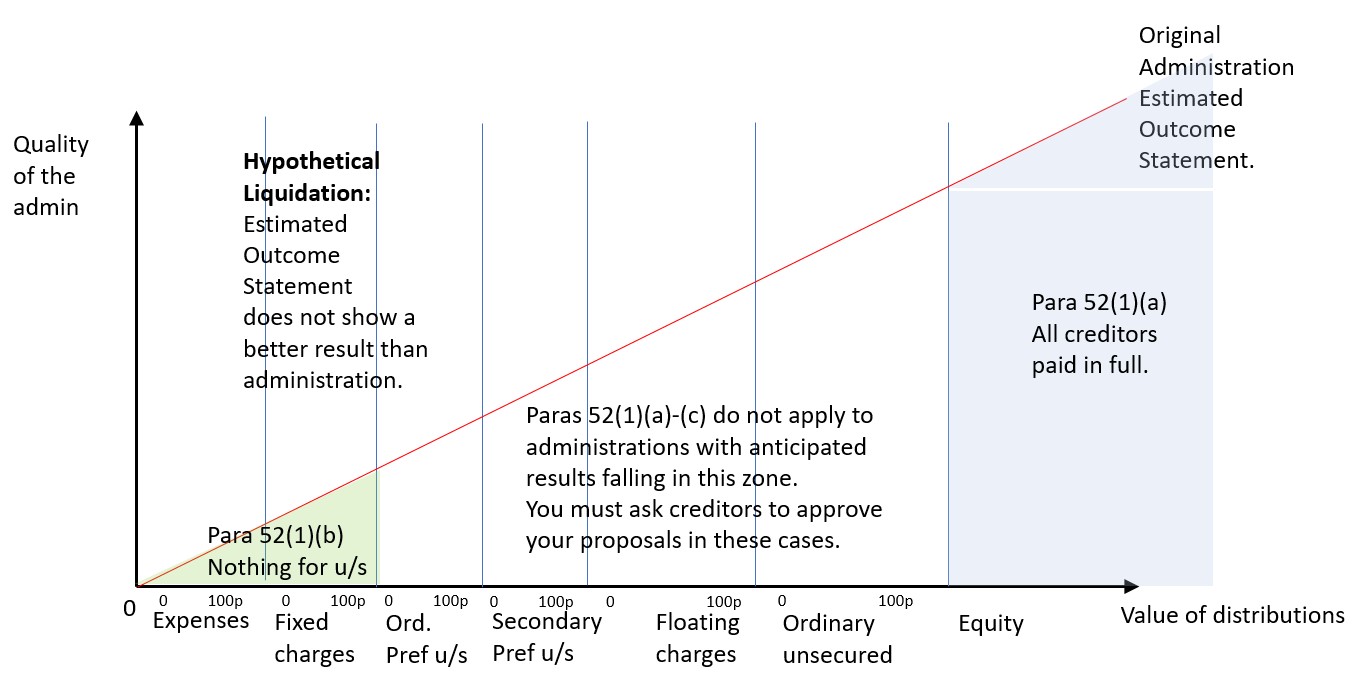
In cases where you think the administration will give better results than the hypothetical liquidation, then paragraph 52(1)(c) wouldn’t apply.
In those cases, paragraph 52(1)(a) would apply if you think all creditors will be paid in full, or paragraph 52(1)(b) would apply if you think you will be unable to pay a distribution to the unsecured creditors.
Cases falling outside of the paragraph 52(1) zones are, of course, those cases which require creditor approval for your proposals.
The procedure for approving the basis of remuneration
You’ll have to decide:
- What basis you want to ask for:
- Time costs
- Ad valorem
- Set fee
- Who is to decide (to the extent that you can influence this):
- Committee
- Creditors
(This may affect the timing of your circulation of the fee estimate)
- Your fee estimate:
- (if asking for time costs)
- (you’ll probably put it in the proposals)
How does the procedure for setting the remuneration basis work?
- If the creditors are to decide (not the committee) – it will be the creditors ‘in the money’ who decide.
- It must be by a decision procedure (you can’t use deemed consent).
- The creditors ‘in the money’ are usually the unsecured creditors.
- Remember: preferential creditors (both sorts) are unsecured.
- But unsecured creditors are not ‘in the money’ if it’s a para 52(1)(b) case. (r18.18)
- In that case, the creditors ‘in the money’ who vote are:
- Secured creditors (by unanimous consent); and
- (But only if you’re going to pay them) Prefs (by decision procedure)
The conflict between the statutory purpose and paragraph 52(1)(b)
There’s a bit of a conflict between the statutory purpose for administration (when it is is realising assets for the benefit of either secured or preferential creditors), and paragraph 52(1)(b) (which applies only if there’s going to be nothing for unsecured creditors).
So, it seems that paragraph 52(1)(b) won’t apply if you think you are going to be realising assets for the benefit of preferential creditors. Yet, paragraph 52(1)(b) is intended to apply when you are realising assets for the benefit of preferential creditors.
To work through this conflict:
Remember:
- It’s what you say in your proposals that fix it on the para 52(1)(b) track (the opinion you state at the time when you publish the proposals.)
- That ‘fix’ lasts for the full duration of the administration.
It’s a 52(1)(b) case if you say, in the proposals that you think the company hasn’t enough to pay unsecured creditors (except through the prescribed part).
- If that’s what your EOS shows, that’s probably enough to trigger para 52(1)(b).
So, you may find yourself asking creditors to approve the basis for your remuneration in a para 52(1)(b) case. This may happen in cases where:
- Perhaps you didn’t think there were any preferential creditors (when you published your proposals)?
- Perhaps you’ve got more assets than you expected (when you published your proposals)?
Who approves the basis for your remuneration?
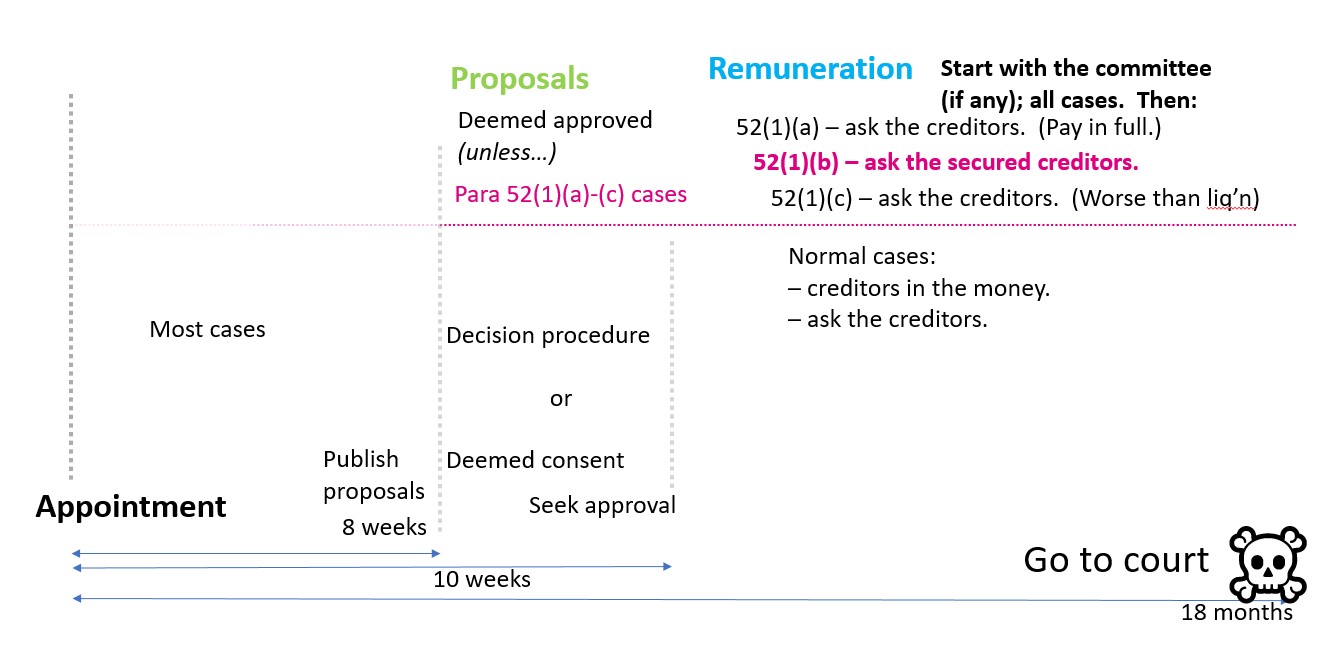 If all else fails, you can go to court. You have 18 months to go to court. Don’t be late.
If all else fails, you can go to court. You have 18 months to go to court. Don’t be late.
But try again first with:
- Committee.
- Creditors ‘in the money’.
The judge will want to know what they think; ‘I haven’t asked them’ would be a bad answer.
Insolvency Law: Coffee Break Briefings
If you would like to stay up to date with the latest developments in insolvency law, you can sign up to our mailing list. You will also receive invitations to all webinars, briefings and events. My next Coffee Break Briefing will take place on September 13th, where I will be looking at Zombie Litigation.
Insolvency & Restructuring Solicitors near London, in Hampshire & Dorset, near Southampton and in Bournemouth, Poole, Christchurch and The New Forest
We hope you found the briefing useful. If you are an insolvency practitioner who would like to discuss the content of this article, please do not hesitate to get in touch.





Comments